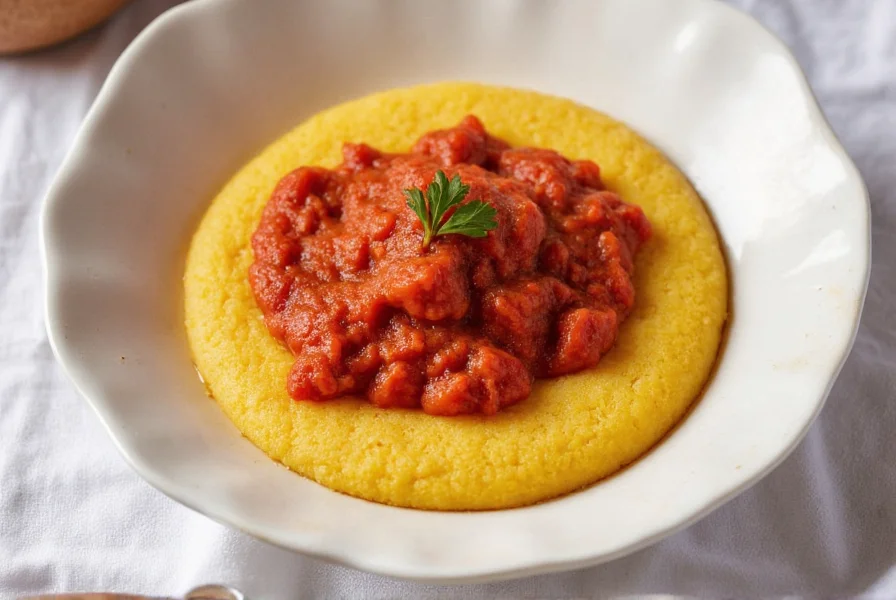Table of Contents
Easy Polenta Red Sauce Recipe
Here's how to make restaurant-quality polenta red sauce at home in under 45 minutes. This recipe delivers rich flavor with perfect spice balance, using simple ingredients you likely already have.
Ingredients
- 2 (28-ounce) cans San Marzano whole peeled tomatoes
- 3 tbsp extra virgin olive oil
- 4 garlic cloves, minced
- 1 tsp crushed red pepper flakes (adjust to taste)
- 1 tsp dried oregano
- 1 tsp smoked paprika
- 1 tbsp tomato paste
- 1/4 cup fresh basil, chopped
- 1/2 tsp salt (or to taste)
- 1/4 tsp black pepper
Step-by-Step Instructions
- Toast the spices: Heat olive oil in a large saucepan over medium heat. Add garlic and red pepper flakes, sauté for 1 minute until fragrant but not browned.
- Bloom the tomato paste: Stir in tomato paste and cook for 2 minutes, stirring constantly to deepen flavor.
- Add tomatoes: Pour in canned tomatoes, crushing them by hand as you add them to the pan. Add oregano, smoked paprika, salt, and pepper.
- Simmer: Bring to a gentle boil, then reduce heat to low. Simmer uncovered for 25-30 minutes, stirring occasionally, until thickened.
- Finish with fresh herbs: Stir in chopped basil just before serving. Taste and adjust seasoning as needed.

The Flavor Profile: Spice, Heat, and Soul
Polenta red sauce isn't just about tomatoes. Its soul comes from the careful balance between acidity, sweetness, and spice. Here's what makes it sing:
- Tomatoes: San Marzano tomatoes provide sweet, low-acid base for perfect balance.
- Garlic: Roasted for mellow depth or raw for punchy bite.
- Herbs: Basil, oregano, thyme — fresh is best for vibrant flavor.
- Olive Oil: Quality extra virgin adds richness and smooth texture.
- Heat: Crushed red pepper flakes, chili powder, or smoked paprika create the signature kick.
How Spicy Can It Get?
| Spice Level | Ingredients Used | Heat Range (Scoville Units) |
|---|---|---|
| Mild | Paprika, minimal red pepper flakes | 500–1,000 SHU |
| Medium | Crushed red pepper, chili powder | 2,500–15,000 SHU |
| Hot | Habanero, ghost pepper infusion | 100,000–1,000,000 SHU |
Why Homemade Beats Jarred Sauce
While store-bought sauce is convenient, homemade polenta red sauce offers superior flavor and flexibility:
- Full control: Adjust spice, salt, and sweetness to your exact preference
- No additives: Avoid preservatives, thickeners, and excess sugar
- Freshness: Homemade sauce has brighter, more vibrant flavors
- Cost-effective: Batch cooking saves money long-term
Jarred vs. Homemade Comparison
| Criterium | Homemade | Store-Bought |
|---|---|---|
| Taste Control | ✅ Fully customizable | ❌ Pre-seasoned, often sugary/salty |
| Cost per Serving | 💰 $2–$4 for a batch | 💰 $4–$8 per jar |
| Prep Time | ⏳ 30–45 mins | ⏱️ Instant ready |
| Shelf Life | ❄️ Freezable for 3+ months | 📅 6–12 months unopened |
Spice It Up: Pro Tips for Maximum Flavor
Take your sauce from good to exceptional with these expert techniques:
- Toast spices first: Dry roast crushed red pepper, cumin, or smoked paprika before adding tomatoes for deeper flavor
- Add anchovy paste: 1 tsp blends seamlessly for umami richness without fishiness
- Use fire-roasted tomatoes: Natural smokiness elevates the entire sauce
- Finish with vinegar: 1 tsp red wine vinegar brightens and balances richness
- Brown butter finish: Swirl in 1 tbsp browned butter for nutty complexity
- Top with fresh chilies: Diced jalapeño or serrano peppers add fresh heat
- Steep fresh herbs: Let basil or thyme steep in warm sauce for aromatic depth

Polenta Red Sauce Pairings That Pop
Move beyond basic polenta with these creative serving ideas:
- Grilled chicken skillet: Crispy chicken thighs over creamy polenta with sauce
- Vegan mushroom ragu: Hearty mushrooms and lentils simmered in the sauce
- Seafood surprise: Pan-seared scallops or shrimp nestled on polenta
- Stuffed bell peppers: Sauce as base layer with quinoa and black beans
- Bruschetta crostini: Spoon cooled sauce onto toasted bread for appetizer
Pantry Essentials for Best Results
Tomato Bases
- Best Overall: San Marzano Whole Peeled Tomatoes (sweet, low-acid)
- Best Budget: Muir Glen Organic Fire-Roasted Tomatoes (smoky depth)
- For Intensity: Passata or Tomato Puree (concentrated flavor)
Olive Oils
- Classic: Bertolli Extra Virgin Olive Oil (smooth and versatile)
- Flavor Kick: Chili or Garlic Infused Olive Oil (instant punch)
Spices & Seasonings
- Dried Chilies: Crushed Red Pepper Flakes (affordable heat)
- Smoked Paprika: La Chinata (rich, sweet smokiness)
- Chili Powder: McCormick Ground Chipotle (balanced heat)
- Garlic: Fresh cloves or roasted garlic paste (depth)
Herbs
- Fresh Basil: For finishing (brightens sauce dramatically)
- Dried Oregano: Toast in oil first for maximum aroma
- Thyme or Rosemary: Excellent for long-simmered versions

Frequently Asked Questions
What is the difference between polenta red sauce and regular marinara?
While both are tomato-based, polenta red sauce is specifically crafted to complement creamy polenta. It typically has a bolder spice profile, richer umami elements, and is often slightly thicker than traditional marinara to cling perfectly to the soft polenta.
Can I make polenta red sauce vegetarian or vegan?
Absolutely! The base sauce is naturally vegetarian, and can easily be made vegan by omitting any optional dairy or meat-based ingredients. Many traditional versions are already plant-based, relying on tomatoes, herbs, garlic, and olive oil for flavor.
How long does homemade polenta red sauce last in the refrigerator?
Properly stored in an airtight container, homemade polenta red sauce will stay fresh in the refrigerator for 5-7 days. For longer storage, freeze it in portions for up to 3 months - the flavors often deepen and improve after freezing!
What's the best way to reheat polenta red sauce?
Gently reheat sauce over low heat on the stove, stirring occasionally. If it's too thick after storage, add a splash of water, broth, or even the liquid from canned tomatoes to reach your desired consistency. Avoid microwaving for best flavor retention.
Can I use fresh tomatoes instead of canned for polenta red sauce?
Yes, but with some considerations. During peak tomato season, use ripe plum or Roma tomatoes (about 2.5 lbs for a standard batch). Blanch, peel, and seed them first for best texture. Keep in mind fresh tomato sauce will be brighter but less concentrated than canned - you may need to simmer longer to achieve proper thickness.
Why does my polenta red sauce taste too acidic?
Tomato acidity can be balanced several ways: add a pinch of sugar (¼ tsp at a time), a splash of red wine, or a small amount of baking soda (⅛ tsp). A grated carrot simmered in the sauce also naturally sweetens while adding depth. Remember that flavors mellow as the sauce rests overnight.
What are good substitutes if I don't have polenta?
If polenta isn't available, creamy mashed potatoes, soft grits, or even polenta-style instant cornmeal products work well. For a gluten-free alternative, try creamy cooked millet or soft-cooked quinoa. The key is having a mild, soft base that can carry the robust sauce.
Your Perfect Polenta Sauce Awaits
Polenta red sauce may seem simple, but it's anything but boring. Whether you're dialing up the heat or going for a mellow herbaceous vibe, this sauce is a canvas for creativity.
So next time you're staring at a pot of polenta, reach not for the shelf-stable jar, but for your spice rack. Play with flavors, experiment with textures, and above all — have fun. Because once you've tasted your own version of polenta red sauce, there's no turning back.
And remember: the secret ingredient is always passion. Or maybe a little extra crushed red pepper. Either way, you'll know when you hit the mark — your taste buds will thank you.










 浙公网安备
33010002000092号
浙公网安备
33010002000092号 浙B2-20120091-4
浙B2-20120091-4